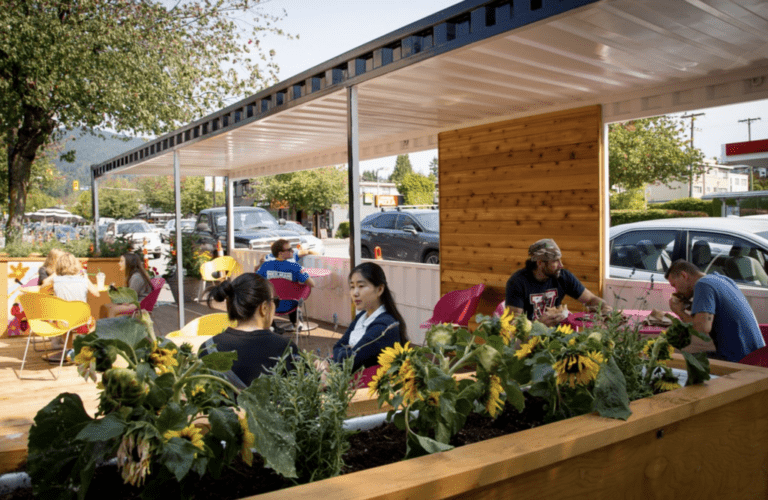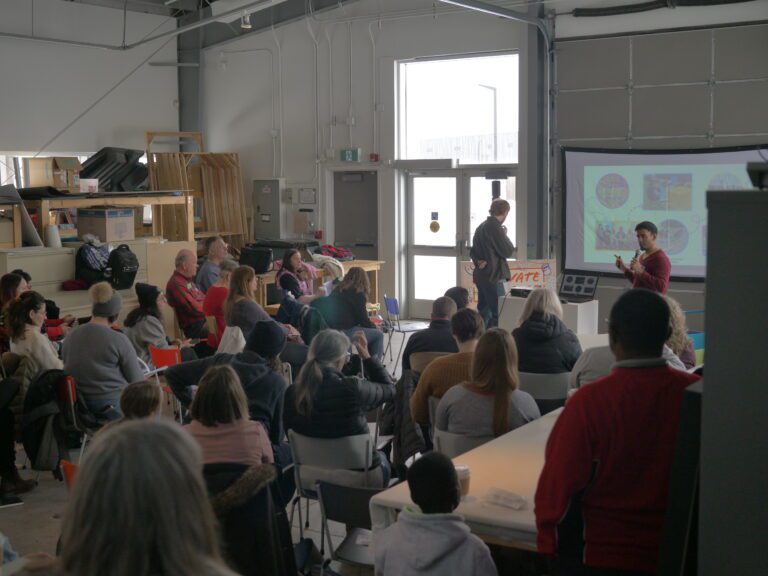A public bench in Mount Pleasant, Vancouver. Photo by Anson Ching
Happy Cities is an urban planning, design, and engagement consulting firm and certified B Corp. that works with clients around the world to create happier, healthier and more inclusive communities. Canada’s Placemaking Community partnered with Happy Cities to develop The Power of Placemaking research project.
This article was written by Anson Ching and is reposted from the Happy Cities blog.
Placemaking is like a box of chocolates
By: Anson Ching, Happy Cities
One sunny day, I met an elderly couple while reading on a bench near my home in Mount Pleasant, a neighbourhood in Vancouver where trendy stores butt up against auto body shops, 1970s block-style apartments, and retirement homes. Our time together on that bench only overlapped for 15 minutes, but in a Forrest Gump sort of way, by the time I got up and left, I had already learned the story of their lives.
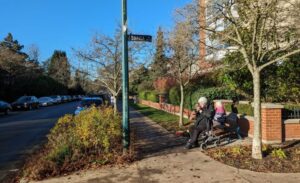
A typical bench on a street corner in Mount Pleasant, Vancouver. Photo by Anson Ching
Something curious happens when you put a bench along a sidewalk. People stop and take a seat. There are, after all, plenty of reasons to do so. Maybe it’s to type an email or to return a call. Perhaps it’s to rest your arms mid-grocery run. Or maybe it’s just to people-watch. Something even more curious happens when that bench is wide enough for two or more people to sit comfortably together: A microcosm forms. One suddenly has the potential to connect with strangers and engage in small conversations. These chance encounters are one of the key drivers for health and wellbeing—just as important to our wellbeing as our relationships with friends and family.
Take a seat for street’s sake!
Today, urban planners are rethinking what it means to transform simple spaces and streets into places to be—and exploring the benefits of this placemaking for wellbeing, mental health, and social connectedness. These transformations can range from creating extravagant plazas to simply setting up places for people to sit on seemingly random street corners.
One recent example is a “friendship bench” initiative from the Canadian Mental Health Association Windsor-Essex that aims to help people struggling with mental health and loneliness. The organization installed eight blue “friendship benches” to create safe outdoor places for people to connect and chat. Each bench has a QR code to direct people to local mental health services and resources, helping the organization reach people who may not otherwise have access to mental health care. Similar projects like this have been implemented across the globe, from Zimbabwe to the United Kingdom.
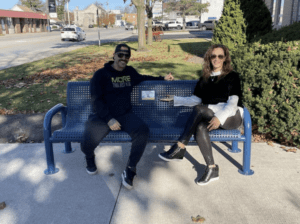
A friendship bench. Photo by the Canadian Mental Health Association Windsor-Essex.
The bench that I was sitting on when I encountered the elderly couple was an old train station bench made of wrought iron. Any thoughtfully placed and designed seating arrangement can have the same effect, bringing people together when they least expect it. Think movable seats, picnic tables, tiered or stadium-style seats, and even steps—from humble steps built into a raised garden feature, to grandiose steps leading up to a landmark building like the Vancouver Art Gallery.
Sitting down is just the beginning.
Public seating options are foundational to the sociability of a place. If placemaking is—as the Project for Public Spaces says—at “the heart of every community,” then providing a place for people to plop down is critical to good placemaking. Seating is also practical: It offers a place to pause and rest, which can be especially important for accessibility—for families, older adults, people with mobility challenges, people living with dementia, and others.
In the Power of Placemaking project, Happy Cities partnered with the Healthy Communities Initiative to explore the impact of community-led placemaking projects on people’s wellbeing. We defined placemaking as both the process and outcome of bringing people together from all walks of life. By creating reasons for people to spend time in public spaces, placemaking can help spark conversations between strangers. In turn, these interactions help strengthen community connections, build a sense of belonging and agency, and contribute to a more vibrant public realm.
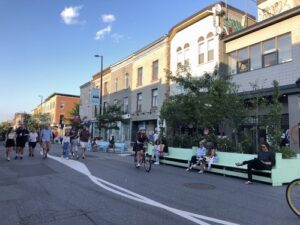
Old church pews, painted and repurposed as seating and planter boxes. Photo by Emma Avery.
Placemaking looks like a lot of things. Vancouver, for example, has transformed a number of street blocks into neighbourhood plazas with paint, picnic benches, planter boxes—and seating. In 2019, a Happy Cities study of this Pavement-to-Plaza program found that people were 33 per cent more likely to want to meet new people in the plazas, compared to regular street blocks nearby.
When residents help shape public spaces, it further strengthens their sense of belonging and pride in a place. For example, in Portland, Oregon, after lower-income residents co-designed new placemaking features for their streets—including benches, gardens, art, and trellises—over half of the residents reported that their community was better for having stronger social ties, an enhanced sense of place, and higher levels of participation. Anyone can take the lead in placemaking interventions, especially on small-scale initiatives like adding places to sit. For example, in Calgary, a local community association added 60 plastic chairs on pathways, in parks, and on condo patios through a $1,000 grant and support from local Home Depot stores. The movable chairs grew to reflect the community’s social dynamics, as residents started to rearrange the chairs into organic social nooks. The chairs raised awareness for the organization and, more importantly, helped foster neighbourliness.
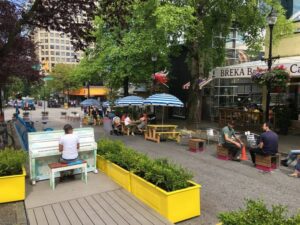
Bute-Robson Plaza. Photo by Paul Krueger / Flickr.
Small but considerate moves
We are all participating in and reaping the benefits of placemaking. In my case, the versatility of a simple bench on the corner of a sidewalk helped connect me to an elderly couple for a brief moment. I knew I could read my book under the sun, and they had planned to rest there in the middle of their routine walk. But there were also many other factors at play, which influenced our decisions to sit there.
Even a placemaking intervention as simple as a bench requires a whole set of considerations. At the corner of slow intersections, these benches are set back enough for people to feel comfortably removed from the street—from its noise pollution and the potential to be overwhelmed by too much bustling activity. At the same time, they are close to enough foot traffic to feel safe. The benches are also south-orienting, for maximum sun exposure, which invites people to linger. And don’t forget the actual design of the benches themselves—whether the design is conducive for universal access.
Placemaking is therefore a holistic approach, shaped by the needs and participation of all types of community members. Any public space can always become more attractive for people to use and linger and, better yet, intentionally inclusive and accessible. Benches and public seating are a small starting point.
Can I tell you my story?
On that day at the bench where I met the elderly couple, two strangers felt comfortable enough to introduce themselves to me. I learned their names, when they retired, what they used to do for a living, and more. They told me how each of them escaped their homelands in the years preceding the Second World War, how they met and married as enlisted service members in a different war, and how they lost their son to an accident years later. And after all that, they told me that they still looked forward to the things to come. After all, you never know what you’re going to get in life, just as you never know what you’re in for when you sit down on a bench next to a stranger. As someone who works in urban planning, I wonder if people are extra humoured by the “Life is like a box of chocolates” scene in Forrest Gump because it seems far-fetched for someone to tell their life’s story to strangers sharing the bench at the bus stop. Perhaps in the future, when more of our streets and urban landscapes are reclaimed as places for people, the scene will not seem as larger than life.
Learn more about the wellbeing benefits of community-led placemaking initiatives in the Power of Placemaking research report, developed in partnership with Happy Cities. Find and download resources from the report to help you make the case for placemaking in your community!

